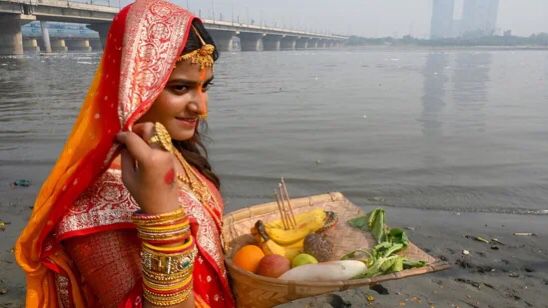Chhath Puja 2025: Four-Day Festival, Rituals, Timings, and Significance

New Delhi | October 24, 2025 Chhath Puja, one of the most revered Hindu festivals dedicated to Lord Surya (the Sun God) and Chhathi Maiya, is set to be observed from Saturday, October 25, to Tuesday, October 28, 2025. Celebrated primarily in states such as Bihar, Jharkhand, Uttar Pradesh, Madhya Pradesh, and West Bengal, the festival is a time for devotion, fasting, and thanksgiving. It is observed six days after Diwali and holds deep cultural and spiritual significance for devotees, particularly women, who perform rituals for the well-being of their families and children. The four-day festival follows a carefully structured calendar, with each day holding unique rituals and observances. The first day, known as Nahay Khay, begins the festival on October 25. On this day, devotees take a holy dip in a sacred river or water body, purifying themselves both spiritually and physically. Following the bath, a simple, wholesome meal is consumed, marking the commencement of the Chhath Vrat. The sunrise and sunset timings on this day are 6:28 AM and 5:42 PM, respectively. The second day, Kharna, falls on October 26. This day is dedicated to fasting without water from sunrise to sunset. Devotees prepare a special meal, usually kheer (rice pudding), which is first offered as Prasad to the Sun God and then consumed after sunset to break the fast. This ritual symbolizes discipline, devotion, and gratitude, reflecting the spiritual essence of Chhath Puja. Sunrise is at 6:29 AM and sunset at 5:41 PM on Kharna day. The third day, Sandhya Arghya, observed on October 27, is considered the most sacred and intense day of the festival. Devotees maintain a rigorous fast throughout the day, abstaining even from water. The evening Arghya, a central ritual, involves offering prayers to the setting Sun at riverbanks or water bodies, accompanied by chants, songs, and offerings of fruits and flowers. This evening ritual, timed at 5:40 PM for sunset, is the spiritual culmination of the first three days of fasting and devotion. Families come together, and the sense of community and shared faith is deeply felt during this observance. The festival concludes on October 28 with Usha Arghya and Parana. Devotees return to the river or water body before dawn to offer the morning Arghya to the rising Sun, scheduled for 6:30 AM. This final ritual marks the successful completion of the nearly 36-hour fast. After offering prayers and receiving blessings, devotees break their fast with Prasad and water, a practice known as Parana. The conclusion of Chhath Puja is both a moment of relief and deep spiritual fulfillment, as devotees celebrate their devotion, perseverance, and the blessings of the Sun God. Chhath Puja is not only a festival of fasting and prayers but also a celebration of nature and gratitude. The emphasis on rivers, water bodies, and the Sun reflects ancient Indian traditions of harmony with the environment. Across the country, devotees follow the rituals with devotion, singing folk songs and engaging in collective worship, making Chhath Puja a deeply immersive and culturally rich festival. In 2025, as devotees prepare to observe this sacred festival, attention to cleanliness and safety at ghats and water bodies has been highlighted by local authorities, ensuring that the spiritual and communal essence of Chhath Puja continues seamlessly. Chhath Puja 2025: Four-Day Festival of Devotion and Fasting Chhath Puja 2025 will be celebrated from October 25 to October 28, honoring Lord Surya and Chhathi Maiya. The four-day festival includes Nahay Khay, where devotees take a holy dip and eat a simple meal; Kharna, a day-long fast broken after sunset with special offerings; Sandhya Arghya, the evening prayer to the setting Sun; and Usha Arghya, the final morning offering and Parana to break the fast. Observed mainly in Bihar, Jharkhand, Uttar Pradesh, Madhya Pradesh, and West Bengal, the festival emphasizes devotion, gratitude, and family well-being, with sunrise and sunset rituals marking each day’s spiritual significance.




